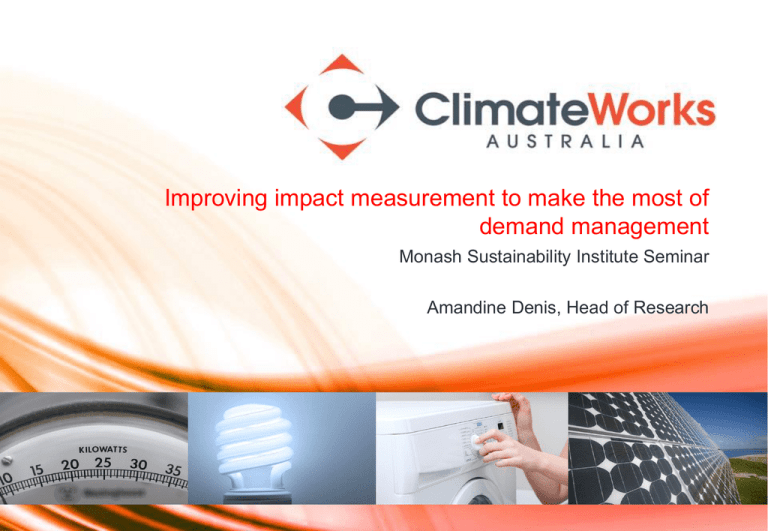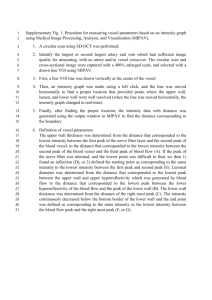Improving impact measurement to make the most of demand management
advertisement

Improving impact measurement to make the most of demand management Monash Sustainability Institute Seminar Amandine Denis, Head of Research Why demand management? • Network upgrades will be the main component of electricity price increase in the next few years • Increase in peak demand drives the need for new infrastructure • Demand management can avoid or differ the need for infrastructure upgrades Benefits to distributors Benefits to consumers • However, most of the time, split incentives exist SOURCE: The Climate Institute, Electricity prices: the facts (2011) 1 Ergon Energy is an atypical case where incentives align •1 Financial benefits due to •2 Other benefits vertical integration - Postponing costly infrastructure upgrades to link remote communities to the main network - Decreasing consumption of diesel in off-grid remote communities - Better insight into customer requirements and practices - Improved customer satisfaction • Reduced energy costs • Increased ‘value add’ through incentives, rebates and in-home consultation Ergon Energy has conducted a number of demand management programs in the last 5 years, and they asked us to help them understand what are the relative financial benefits of each option SOURCE: Ergon Network Management Plan 2011/12 to 2015/16; CRA report, 2006 2 We analysed six of Ergon’s demand management trials Aimed at reducing overall energy consumption (diesel generation): PowerSavvy – intensive consultation program in three isolated communities Aimed at reducing peak demand for electricity: Energy Savers – low-intensity consultation program in Mackay and Mt Isa suburbs Townsville Solar city program – high-intensity consultation program in Townsville suburb + solar panels installation program Ergon requested help to compare the efficiency and effectiveness of various demand management programs based on past trials… Rewards Based Tariffs – pricing system to incentivise demand reduction on extreme peak days Air conditioning direct load trial - incentive to install load controllers on existing AC systems, controlled by Ergon Pool pumps trial – incentive to investigate ways to reduce pool pump demand in peak periods SOURCE: ClimateWorks analysis …and also to define what optimised versions of programs would look like. 3 In order to create the program cost curve, we followed a five-step process •A First, we estimated the baseline consumption profile for the average household targeted by past programs (North Queensland) •B Second, we assessed the savings that could be delivered by a set of actions undertaken by a typical household •C Third, we analysed the programs: how many households can be expected to take up a program, and how much savings can be expected for each household taking up the program (more complex for consultations) •D Fourth, we assessed how much reduction would remain after 5 years to make all programs comparable •E Finally, we assessed how the costs would decrease if the programs were to be operated at larger scale SOURCE: ClimateWorks analysis 4 A First, we estimated the baseline consumption profile for the average household in the regions targeted by demand management programs Peak demand definition: extremely hot summer day, maximum hourly consumption (typically within 5pm-8pm) Average per household, % of total consumption Total = 4.1 kW By end use By piece of equipment (top 10) Other Cooking Microwave Fans 12% 11% Electronics and entertainment Cooling 57% 5% 3% 2% Electric oven 4% Refrigerators 5% Lighting 10% 4% Pool 5% 54% Lighting 5% Refrigeration 0% 5% 1% Pool 1% 3% Appliances Water heating Space heating Laundry 7% Electric cook-top Air Conditioners 7% Televisions 3 pieces of equipment make up 2/3 of peak demand SOURCE: ClimateWorks analysis 5 B Second, we assessed the savings that could be delivered by a set of actions undertaken by a typical household Replace electric hot water system with a solar system Service Air conditioner check filter, refrigerant levels and clear vegetation) Upgrade from old 2* fridge to new 3.5* Switch to gas for cooking – oven Use shading (curtains and pelmets) Fit load controllers to new medium air conditioners (demand ready AC) Switch to gas for cooking - cooktop Weather-strip homes Replace electric hot water system with gas storage/continuous flow or 5 star storage Upgrade to a 7 + star LCD TV (from average 5 star) Run pool filter outside of peak times (4pm to 8pm) Do not use appliances during peak times (4pm to 8pm) Turn off/surrender second fridge Install water efficient tap fittings (tap aerators) Cost to household ($/yr) 250 100 50 0 0.0 0.4 0.8 -50 -200 -250 -300 -350 1.6 2.0 2.4 Peak demand savings available (kW/HH)* Paint roof white Turn off TVs when not in use -100 -150 1.2 Turn off lights when not in the room Upgrade your ceiling insulation from R2 to R4 Placing the fridge to allow for air circulation around the coils Change thermostat on fridge Do not use electric stove during peak times (4pm to 8pm), use BBQ/pre-cooked meals Install water-efficient low flow showerheads/roses Switch incandescent bulbs to CFLs Switch traditional halogens to high-efficiency halogens Buy 7+ star LCD TV to replace plasma TV Buy best-in class AC instead of average AC Switch appliances off at the wall to reduce standby load Replace electric hot water system with an electric heat pump system Behaviour changes – continuous Change air conditioning temperature to 25 degrees Behaviour changes – one-off Change old AC to new AC Use fan in conjunction to AC Purchase/ retrofit decisions Swap pool pump to T33 Upgrade your pool pump filter to a new unit that complies with new 2009 MEPS SOURCE: ClimateWorks analysis * Does not include interaction between different actions represented 6 C The impact of a program is the sum of the impact of each action promoted Driven by equipment ownership profile and attractiveness of actions to households Expected savings from program (on average per household) = Expected % households taking up program Expected savings from action X x x Expected % households taking up action X + Expected savings from behaviourbased actions technologybased actions Driven by community size and receptivity Driven by baseline and actions impact calculations Driven by community size and receptivity 7 C For different community categories, we identified how many actions lead to the lowest unit cost for Ergon Peak demand reduction Rebate Operating cost ($/kW) Given for free by Ergon Installed by Ergon Replace electric hot water system with an electric heat pump system 30,000 Replace electric hot water system with a solar system Install water-efficient low flow showerheads/roses Weather-strip homes Weather-strip homes Upgrade your ceiling insulation from R2 to R4 Swap pool pump to T33 Switch to gas for cooking - oven Switch incandescent bulbs to CFLs in living areas Fit load controllers to new medium AC Switch traditional halogens to highefficiency halogens in living areas 0 0.025 0.050 0.075 0.100 0.125 Paint roof white Rebate - Swap pool pump to T33 0.150 0.175 Optimum set of activities for urban high and low intensity consultation programs 0.200 0.225 Peak demand savings (kW/HH)* Switch incandescent bulbs to CFLs - living areas Switch traditional halogens to high-efficiency halogens - living areas Switch to gas for cooking - cooktop SOURCE: ClimateWorks analysis * Does not include interaction between different actions represented 8 D Fourth, we assessed how much reduction would remain after 5 years to make all programs comparable Persistence of activities over time Percentage of original impact, % 100 No attrition 90 80 70 60 10% attrition per year 50 40 30 20 10 0 Year 0 SOURCE: ClimateWorks analysis Year 1 Year 2 Year 3 Year 4 Year 5 9 E Finally, we assessed how the costs would decrease if the programs were to be operated at larger scale Cost ($/kW) Cost ($/kW) Rewards based tariffs Urban or suburban areas – high intensity Rewards based tariffs Urban or suburban area – high intensity 0.05 0.10 0.15 0.20 0.25 0.30 0.35 Expected peak demand savings (kW/HH) Urban or suburban areas – low intensity Pool pumps program Air conditioning load control (new units, medium to large) SOURCE: ClimateWorks analysis 0.050 0.100 0.150 0.200 0.250 0.300 Expected peak demand savings (kW/HH) Urban or suburban area– low intensity Pool pumps program Air conditioning load control (new units, medium to large) 10 Based on our analysis, we built a comparison of the different programs to reduce demand in urban and suburban areas Peak demand - Future costs (estimated in case of extension to business-as-usual) Cost ($/kW) Rewards based tariffs 8,000 Urban or suburban area – high intensity 0 0.050 0.100 0.150 0.200 Urban or suburban area – low intensity 0.250 0.300 Expected peak demand savings (kW/HH) Pool pumps program Air conditioning load control (new units, medium to large) SOURCE: ClimateWorks analysis 11 Based on our analysis, we built a comparison of the different programs to reduce demand in urban and suburban areas Peak demand - Future costs (estimated in case of extension to business-as-usual) Cost ($/kW) Rewards based tariffs 8,000 Urban or suburban area – high intensity Low cost Large volume 0 0.050 0.100 0.150 0.200 Urban or suburban area – low intensity 0.250 0.300 Expected peak demand savings (kW/HH) Pool pumps program Air conditioning load control (new units, medium to large) SOURCE: ClimateWorks analysis 12 Based on our analysis, we built a comparison of the different programs to reduce demand in urban and suburban areas Peak demand - Future costs (estimated in case of extension to business-as-usual) Cost ($/kW) Rewards based tariffs 8,000 Benefit of postponing Urban or suburban area – high intensity Low cost Large volume 0 0.050 0.100 0.150 0.200 Urban or suburban area – low intensity 0.250 0.300 Expected peak demand savings (kW/HH) Pool pumps program Air conditioning load control (new units, medium to large) SOURCE: ClimateWorks analysis 13 Based on our analysis, we built a comparison of the different programs to reduce demand in urban and suburban areas Peak demand - Future costs (estimated in case of extension to business-as-usual) Cost ($/kW) Rewards based tariffs 8,000 Benefit of postponing Urban or suburban area – high intensity Low cost Large volume 0 0.050 0.100 0.150 0.200 Urban or suburban area – low intensity 0.250 0.300 Expected peak demand savings (kW/HH) Pool pumps program Air conditioning load control (new units, medium to large) SOURCE: ClimateWorks analysis 14 We also built a comparison of programs to reduce annual demand in isolated communities Annual consumption - Future costs (estimated in case of extension to business as usual) Cost ($/MWh) Consultations in isolated communities – low receptivity 1,500 Consultations in isolated communities – medium receptivity 0 0 250 500 750 1,000 1,250 1,500 1,750 2,000 2,250 2,500 Expected Annual consumption savings (kWh/HH) Consultations in isolated communities – high receptivity SOURCE: ClimateWorks analysis 15 Much can be done to improve the outcomes of demand management programs in future •A First, focus on measurement from outset of projects helps to ensure quality data is collected to quantify program success •B Second, potential exists to facilitate data sharing between organisations undertaking demand management programs C Third, potential exists to develop voluntary data collection protocols for consistency and comparability across programs SOURCE: ClimateWorks analysis 16 A First, focus on measurement from outset of projects helps to ensure quality data is collected to quantify program success Collection of quality data at all program stages is key to developing a more robust tool that can better estimate future program costs and benefits, e.g. • Community characteristics • Actions taken • Energy savings • Peak demand reduction • Drivers for take up of program/actions • Cost www.climateworksaustralia.org 17 B Second, potential exists to facilitate data sharing between organisations undertaking demand management programs • Others are also doing trials, both within Australia and internationally • Sharing can improve data gathering and quality of data for all • Examples of how others are doing it well: - International Energy Agency – Demand Side Management Program (INDEEP) www.ieadsm.org - California Energy Commission and California Public Utilities Commission – Database for Energy Efficient Resources (DEER) www.energy.ca.gov/deer/ - Community for Energy, Environment and Development – LEAP (Long range Energy Alternatives Planning System) Technology and Environment Database www.energycommunity.org/ - Minnesota Department of Commerce and Energy – Deemed Savings Database http://mn.gov/commerce/energy/topics/conservation/Design-Resources/DeemedSavings.jsp 18 C Third, potential exists to develop voluntary data collection protocols to ensure consistency and comparability across programs • A voluntary data collection protocol could be used to improve demand management programs. • Developing and agreeing on performance measures and how/when to apply them is a key step in establishing protocol • ClimateWorks and Ergon are keen to collaborate with others on developing this protocol. www.climateworksaustralia.org 19 C Third, potential exists to develop voluntary data collection protocols to ensure consistency and comparability across programs • A voluntary data collection protocol could be used to improve demand management programs. • Developing and agreeing on performance measures and how/when to apply them is a key step in establishing protocol • ClimateWorks and Ergon are keen to collaborate with others on developing this protocol. www.climateworksaustralia.org 20 Questions? Amandine Denis Head of Research E: amandine.denis@climateworksaustralia.org P: (03) 9902 0743 www.climateworksaustralia.org




